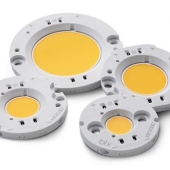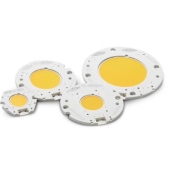Application Note AN32 – Electrical Drive Considerations for Bridgelux Vero LED Arrays
The Bridgelux Vero Series LED Array products deliver high performance, compact and cost-effective solid-state lighting solutions to serve the general lighting market. These products combine the higher efficiency, lifetime, and reliability benefits of LEDs with the light output levels of many conventional lighting sources.
Optimizing performance and reliability of a lighting system using Bridgelux Vero Series LED Arrays requires careful consideration of thermal management solutions, handling and assembly, selection of electronic drivers and selection of secondary optics. Application Notes AN30, AN31, AN32 and AN36 respectively deal with each of these topics in depth. To achieve optimal performance of the LED Arrays, proper electronic drivers must be selected or designed.
A key feature of the Vero LED Array is the wide range of current drive capabilities of each member of the series, making it possible for LED lighting designers to create luminaires that are scalable in optical power output to meet different application needs while keeping the overall mechanical and optical design unchanged. This feature enables luminaire manufacturers to easily offer LED luminaires with a wide range of optical performances and keeping the design and manufacturing cost low because of the economy of scale that the Vero series enables.
The purpose of this application note is to assist designers in selecting or developing electronic drivers for use with Bridgelux Vero LED Arrays. The first step is to become familiar with relevant electrical characteristics of the LED Arrays. This includes the relationship between forward voltage and current, and the relationship between light output (luminous flux) and current. A review of these characteristics results in design rules and recommendations for driving Bridgelux Vero LED Arrays.
The second step is to define LED driver requirements, usually specific to the given application. Design considerations include defining the driver’s input voltage (i.e., AC line voltage input, a combination of ACDC and DC-DC drivers, or DC input from batteries), defining an optimal driver output current, establishing dimming requirements, and determining both temperature and lifetime requirements to satisfy the needs of the application. This application note provides general guidelines to the designer to assist in enabling a successful design.




